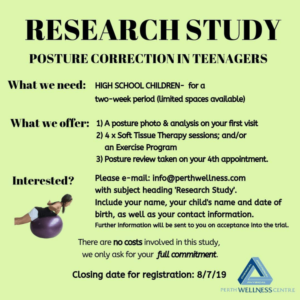We as health professionals believe that anterior posture is becoming a major issue in today’s society and is increasing our risk of injury in everyday life. Whether this is at work, school, home and what we do in our spare time. But where does it all begin? Why is this happening in children?
In teenagers, smartphone addiction has had adverse effects of altered spinal loading, resulting in adaptive neuromusculoskeletal changes. The most prevalent postural deviations that were observed in teenagers are protruding shoulder blades, head forward and hyperlordosis. Lacking physical exercise, spending more time in front of computer screens, laptops, iPads are reasons for these bad habitual postures.
There is a notable higher probability (20% higher) of adopting poor posture among those who do not exercise or are not active in sports, compared to those who are actively involved in sports. It is noted in studies that the occurrence of poor posture was found higher in 11-year-old children than in 7-year-old children. We deduce that high school children are more exposed to technology and have more reasons to be engaged with these devices.
Although there are widespread postural correction interventions being executed, interestingly there is very limited experimental data and statistics that exist to support their effectiveness. Hence, this is a pilot study to evaluate the Effects of Soft Tissue Therapy and Exercises on Posture Correction in teenagers.
 To complete this study, we are looking for healthy children with no obvious restrictions on movement.
To complete this study, we are looking for healthy children with no obvious restrictions on movement.
There is no guarantee your child will be included to complete the study as this will depend on your child’s physical condition, which will be fully assessed during the first appointment. There are no costs involved during the study.
Who is doing the Research?
This project is being conducted by Soo Yin Ooi and Anne Bettink who are fully qualified Occupational Therapists with Perth Wellness Centre. They both specialise in Soft Tissue Therapy (Link) and Rehabilitation.
What is Soft Tissue Therapy?
Soft Tissue Therapy involves direct physical manipulation on the muscle and other soft tissues of your body. There are many benefits to Soft Tissue Therapy. The physical manipulation creates length and blood flow to muscles that need it in order to restore optimal length/tension relationship which is one of the many benefits to Soft Tissue Therapy. Techniques include myofascial and trigger point release using fingers, palms, forearm, and elbow.
What you will be asked to do?
Participants in this study will be invited via phone call to book four (4) respective appointments with our Occupational Therapists. These sessions will be conducted at 9 Colin Street, West Perth at Perth Wellness Centre.
We request that your child commits to four appointments in total. Two (2) appointments in the first week, and two (2) appointments in the second week of the school holidays. The first appointment runs for half an hour. Subsequently, the sessions will be approx. 15 minutes.
Your child would be randomly assigned to receive Soft Tissue Therapy and/or evidence-based Posture Correction exercises:
When your child comes into the clinic, he/she will be required to fill in a patient information form and then one of our friendly staff will be taking a posture photo of your child. This is fully clothed. We ask that your child comes in comfortable activewear with easily removable footwear for the posture-photo.
If your child is given stretches and exercises to do, he/she is advised to comply with doing their stretches/exercises at home. This will involve a commitment of 10 minutes a session TWICE a day. We will require a parent to sign a logbook acknowledging the child has completed these sessions.
Posture photo and analysis will be conducted at the initial appointment and the fourth appointment to view the difference in Posture Correction over this time.
The structure of the program is subject to change depending on the number of participants we gather.
Related Posts
Understanding and Addressing Lymphorrhea
14 September 2020
In humans, the lymphatic system is responsible for removing cellular waste, absorbing those unhealthy fats in the digestive system, maintenance of proper body fluid levels and protecting the entire body from foreign invaders like bacteria that can cause illness.
0 Comments4 Minutes
What is Lymphedema?
16 December 2020
Lymphedema refers to the impaired flow of the body's lymphatic system. Lymph nodes are located throughout the body, and these nodes help to prevent infections and ailments. This system triggers the body's natural healing process and flushes out toxins from the body.
0 Comments3 Minutes


